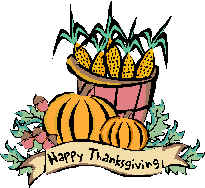| This is part 4 of a number
of facts associated with THANKSGIVING. This is an all American holiday. Although the US
and Canada celebrate the day on different dates, the purpose is the same. |
Part 4Even more first Thanksgivings:
Don Juan de O˝ate was the son of a noble Spanish family. His wife was the
grand-daughter of CortÚz and the great-grand-daughter of Moctezuma. Don Juan de O˝ate
led the first major colonization effort into what is now the United States. He began his
journey in January of 1598. The expedition was made up of more than 400 men. 130 of these
men had their families with them. Several Franciscans also traveled with the colonizers.
Their possessions were packed into 83 ox-drawn, wooden-wheeled wagons and carts, and with
7000-8000 horses, oxen, sheep, goats and cattle, they formed a four-mile long procession
through the desert.
The journey began in Santa Barbara, Mexico, south of Chihuahua and carved a new and
shorter trail through the desert north of El Paso. The expedition plodded through the hot
and torturous desert for more than four months. Supplies were low and the colonists were
often forced to eat roots and berries, drink water from the occasional water holes or from
cactus and other plants. The weary and ragged travelers arrived at the banks of the Rio
Grande on April 20, 1598.
|
The river was indeed a beautiful and refreshing sight. For ten days they refreshed
themselves, drinking their fill of water, swimming in the deep cool waters of the Rio
Grande, and resting in the shade of the giant cottonwoods. They hunted, fished, and ate as
they had not done in months. On April 30, Don Juan ordered all to put on their best
clothes and to gather for a thanksgiving. He memorialized the occasion with a proclamation
(La Toma) that claimed the land for the King of Spain. A play (the first in America?) was
created and presented depicting their success.
The day following the feast the colonists began the last lap of their journey toward a new
life. It took them four days to arrive at the Rio Grande crossing near what is now
downtown El Paso and another four months to reach their final destination north of present
day Santa Fe.
OK – Yesterday and today several examples of early
Thanksgivings in the New World were presented. Why don't we hear much about these
celebrations? Perhaps it is because they were not English speaking settlers.
Tomorrow we look at several more "First Thanksgivings," from English colonists. |



